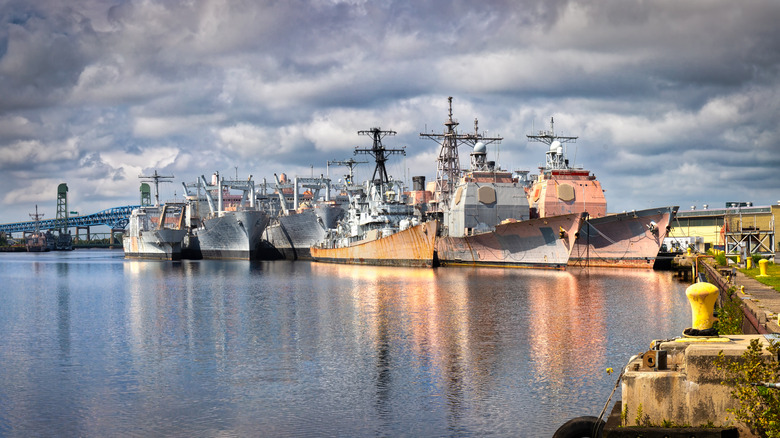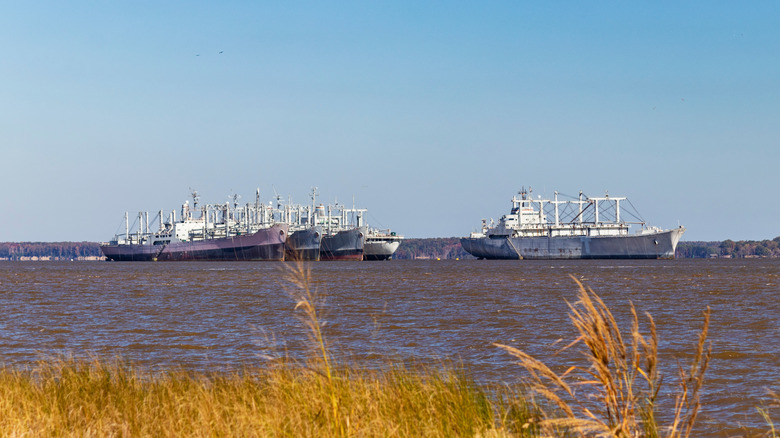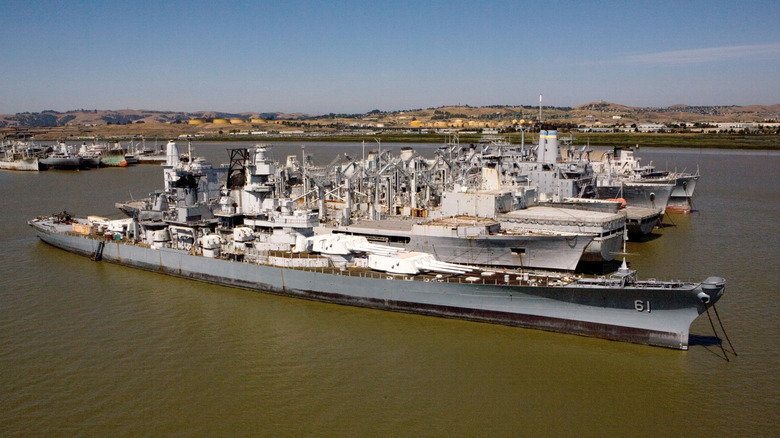What Is The US Navy's Mothball Fleet And How Many Ships Does It Have?
Back in 1965, Lt. George R. Kolbenschlag and Harold E. Switzer wrote in the U.S. Naval Institutes' Proceedings, "The Navy's largest fleet is one which remains at dockside, tied up and unmanned, its guns and magazines empty. This is the Reserve Fleet — more popularly called the mothball fleet." The whole point of being kept in reserve, of course, isn't that they were meant to be tucked out of sight and forgotten, but that they may be needed someday. As such, they should be kept as though this may be the case.
At the time, the so-called mothball fleet comprised around 600 vessels, ranging from cruisers to battleships. However, military priorities and technology have changed a lot in the six decades since, as has the composition and distribution of the mothball fleet. It's not just one fleet housed in a single location within the United States, but rather a term to define a range of collections of vessels kept in reserve. The National Defense Reserve Fleet (NDRF) is often deemed part of the mothball fleet, and it boasted 2,077 vessels in 1950. These numbers fell to 274 by 2003 and plummeted again to 91 by 2021.
These are not necessarily former military vessels, though, but rather those the U.S. Department of Transportation describes as "military-useful former commercial ships to support national defense and contingencies." In terms of former navy ships, Popular Mechanics estimates that only around 50 were in a mothball fleet by 2019.
The National Defense Reserve Fleet and its vessels
The National Defense Reserve Fleet was introduced in 1946. As noted, it isn't a single fleet but is divided into three primary fleets named after their home anchorage. They are the Beaumont, Suisun Bay, and James River Reserve Fleets. Not all 100 or so ships in the overall fleet are intended to ever see service again, and indeed, the Maritime Administration also heads up the United States' Ship Disposal Program. This initiative aims to ensure such vessels have utility to the very end by preparing them to be made into artificial marine habitats or responsibly scrapped . The Navy takes several approaches to decommissioned ships.
The Ready Reserve Force epitomizes the vessels kept ready to be reactivated and boasts 48 ships at present. If called upon, its main objective would be to perform roles that are so critical in the early stages of an emergency, whether military or otherwise, such as the transportation of supplies and equipment. Unlike a lot of reserve vessels, these have servicepeople assigned to them to facilitate reactivation and are typically found in what the Ready Reserve Force refers to as "outports" rather than being kept in an assigned storage place.
Though the National Defense Reserve Fleet offers such options as recycling for vessels that it will ultimately dispose of, the fact remains that there can be considerable issues associated with keeping vessels in reserve as they await their fate.
What happened to the mothball fleet
Generally speaking, the U.S. Navy doesn't have a use for battleships anymore, with aircraft carriers being the new powerhouses of the ocean. These are more technologically advanced, versatile vessels, and huge advancements in missile technology have left the once-so-formidable weapons of battleships largely obsolete. Smaller, more maneuverable and less detectable models that pack a punch can serve as a far more cost-effective approach to firepower. There are some surprisingly small ships in the U.S. fleet. Other factors have led the whole mothball fleet to slowly dwindle away over the years.
Naval vessels have resided Suisun Bay, California, since the end of World War II, in huge numbers at times –340 ships was the record. Its long-time overseer, Joe Pecoraro, took charge of the fleet in 1991, and was quoted by KQED in 2017, saying his father jokingly nicknamed the ships "Joe's rusty navy." This paints a picture of neglect for a range of surplus ships left to rot. More than rust, asbestos and other highly dangerous elements were shed by this mothball fleet, polluting the waters.
The executive director of San Francisco Baykeeper, Sejal Choksi-Chugh, despaired, per the outlet, "...the minute it rained or the minute it got windy, all of that pollution just went right into the bay." In 2009, a total of 57 vessels were ordered out of the bay by a federal court, and the waters near Suisun Marsh improved over the years. As of 2017, only nine ships remained in Suisun Bay.


